#kolemanskop
Photo

#ナミビア歴史ツアー #弾丸ツアー #コールマンスコップ #ゴーストタウン #ダイヤモンドラッシュ #ルーデリッツ #ナミビア #アフリカ ルーデリッツから15キロほど東側にあるコールマンスコップ。1908年、この地域で鉄道労働者によりダイヤモンドが発見されてから発展し、ナミビア砂漠の過酷な環境の中で働く労働者たちにとって格好のオアシスとなっていた。1918年までドイツ領南西アフリカの一部であったことから、村はドイツ風の外見を持ち、病院、ダンスホール、発電所、学校、ボウリング場、劇場、体育館、カジノ、製氷工場(水の無かったこのルーデリッツでは南アフリカのケープタウンから船で水を輸入していてその貴重な水を使って氷を作っていた)そして南西アフリカでは最初の物性研究所もあった(2007年2月現在のデータ)。リューデリッツへの鉄道路線もあった。 この町は、第二次世界大戦後、ダイヤモンドの価格が暴落し、衰退し始める。鉱業はオランジムンドに移っていった。町は1956年には捨てられたが、その後一部復旧した。 観光客が、今、砂の中に半ば埋まってしまった家々の間を歩き回ることができるのも、砂漠の地質学的な特性によるものである。 なお現在もこのエリアから砂や砂利を持ち帰ることは違法とされ見つかると100万ドルの罰金又は刑期に処される。 ウィキペディアより。一部現地ガイドより。 パート2もお楽しみに。 #kolemanskop #luderitz #gohsttown #diamondrush #namibia #africa In 1908, in what was then German South-West Africa, the worker Zacharias Lewala found a diamond while working in this area and showed it to his supervisor, the German railway inspector August Stauch. Realizing the area was rich in diamonds, German miners began settlement, and soon after the German Empire declared a large area as a "Sperrgebiet", starting to exploit the diamond field.[2] Driven by the enormous wealth of the first diamond miners, the residents built the village in the architectural style of a German town, with amenities and institutions including a hospital, ballroom, power station, school, skittle-alley, theatre and sport-hall, casino, ice factory and the first x-ray-station in the southern hemisphere, as well as the first tram in Africa. It had a railway link to Lüderitz. Taking sands and gravel is illegal still today. If you get caught, you’ll get 1 million fine or go to Prison. From Wikipedia and local guide. To be continued to part 2. https://www.instagram.com/p/CpS5Tr8sjlR/?igshid=NGJjMDIxMWI=
#ナミビア歴史ツアー#弾丸ツアー#コールマンスコップ#ゴーストタウン#ダイヤモンドラッシュ#ルーデリッツ#ナミビア#アフリカ#kolemanskop#luderitz#gohsttown#diamondrush#namibia#africa
1 note
·
View note
Text

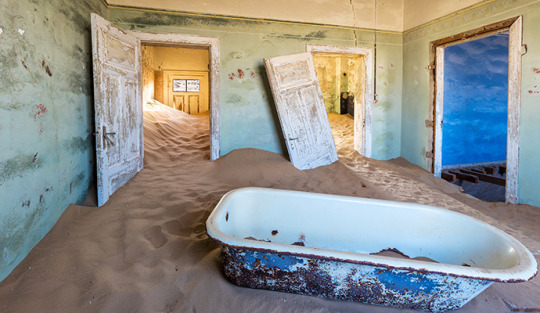
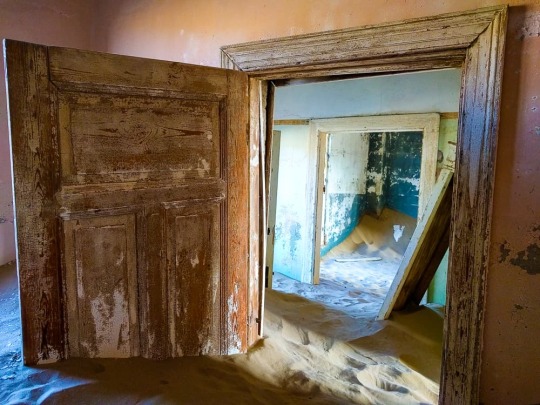
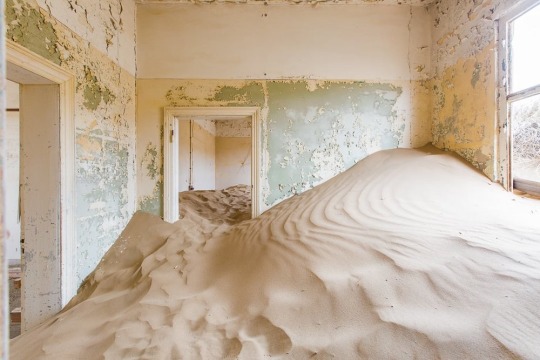
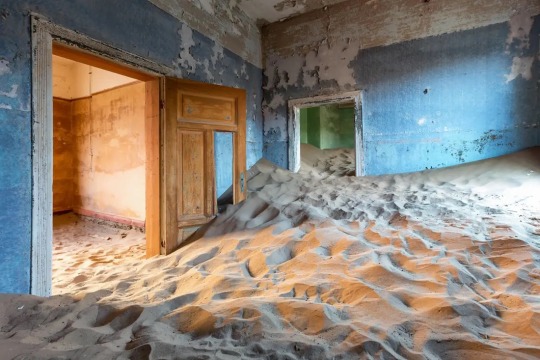
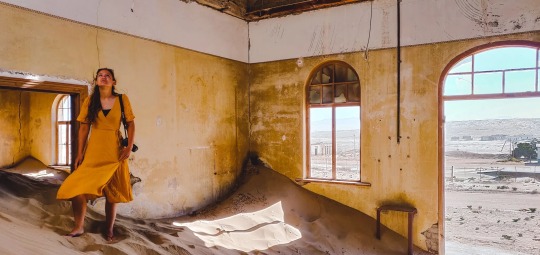
The first abandoned place i am looking into which has been taken over by nature is Kolmanskop, Namibia, it was once a opulent mining town but now its buried under sand. Kolmanskop was at its liveliness in the early 1900s, when Germany miners came to the area to hunt for diamonds. With them, they brought German architecture, giving the desert area an opulent, out of place look. The town featured a ballroom, a hospital, and a bowling alley among other amenities. The towns decline begun shortly after World War One, but the final nail in the coffin was the 1928 discovery of a diamond rich area along the coast. Most of Kolmanskop’s residents hurried to the new hotspot, leaving their belongings and the town behind. The desert has been slowly taking over Kolmanskop ever since. Brightly coloured wallpaper peeling off the walls, dilapidated houses now inundated in rolling banks of sand. This is Kolemanskope, a ghost town in southern Africa’s Namib desert, in the middle of a region known as “the forbidden zone.” And the story of how it got here is about as strange as the sight of the town today. On evening in 1908, a Namibian railway worker named Zacherias Lewala was shovelling railroad tracks clear of creeping sand dunes when he saw some stones shining in the low light. Lewalas German employer identified them for what they were: diamonds. Lewala was not paid or rewarded for his find. Soon, hordes of prospectors descended on the area. By 1912, a town had sprung up, producing a million carats a year. Or 11.7 percent of the worlds total diamond production. Wealthy Kolmanskop became a well of luxury in the barren dessert. There was a butcher, a baker, a post office, and an ice factor; fresh water was brought by rail. European opera groups even came to perform. A sort of mad eccentricity reigned. One family kept a pet ostrich that terrorised other townspeople and was made to pull a sleigh at Christmas. But Kolmanskop was part of the struggling colony of German south west Africa, it was built on a legacy of colonial violence. Only four years before the discovery of diamonds at Kolmanskop, the Namibian Herero people rebelled against the German colonisers, who retaliated with genocidal ferocity by killing over 60,000 Herero. Kolmanskop prospectors were becoming rich overnight simply picking diamonds off the desert floor, but German authorities wanted greater control over the incredible riches. They cracked down, declaring a vast area of Namibia a sperrgrbiet, or restricted zone, forbidding entry to ordinary and reserving prospecting rights for a single, Berlin based company. Tribespeople displaced from their land by the zones construction were often employed as labourers in diamond miners, forced to live on cramped, barracks like compounds for months at a time. But it wasn’t to last. Intensive mining depleted the area by the 1930s, and in 1928 the towns fate was sealed when the richest diamond fields ever known were found on the beach terraces to the south. The townspeople left in droves, abandoning homes and possessions. By 1956, Kolmanskop was completely abandoned. The dunes that once rolled over Lewalas railway tracks now burst through the ghost towns doors and porches, filling its rooms with smooth banks of sand. During a brief heyday, about a thousand people- German colonisers and their families as well as local tribespeople who worked the mines lived in Kolmanskop. In 2002, a local private company called ghost town tours was awarded the concession to manage Kolmanskop as a tourist attraction, bussing visitors into the forbidden zone to explore and photograph the sand covered ruins. Today, as many as 35,000 tourists visit the site every year, bringing money to the nearby coastal town of Luderitz.
0 notes